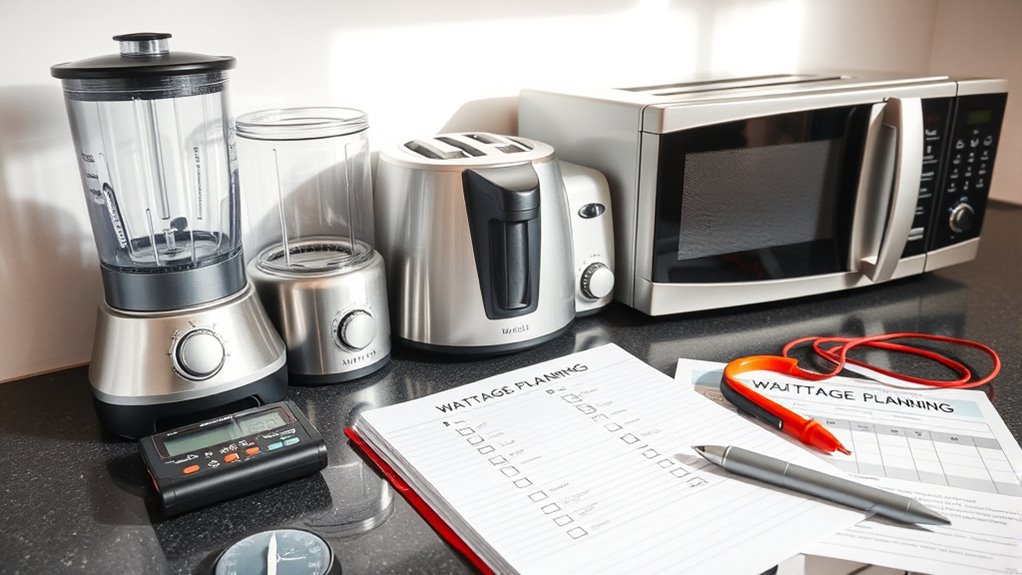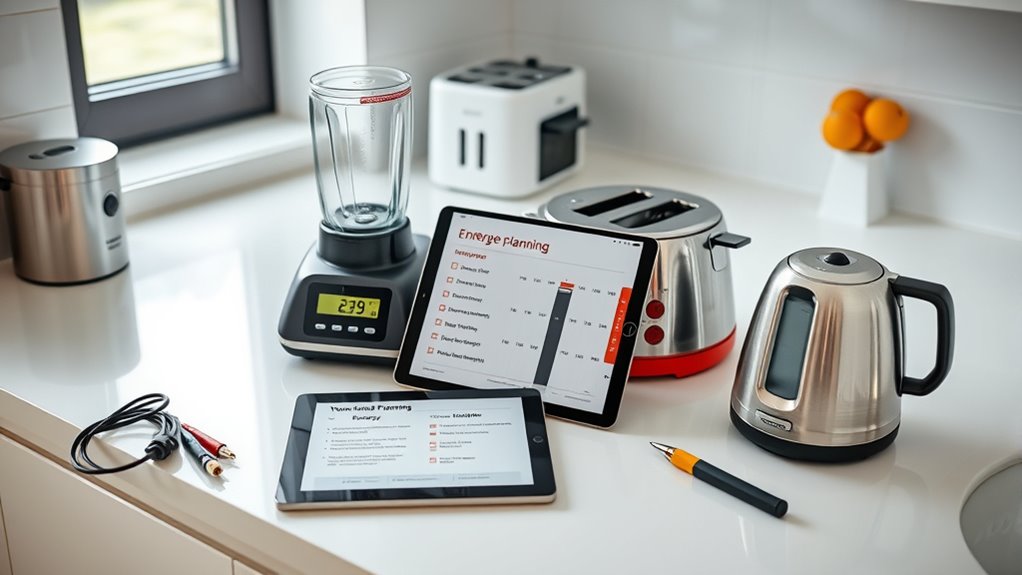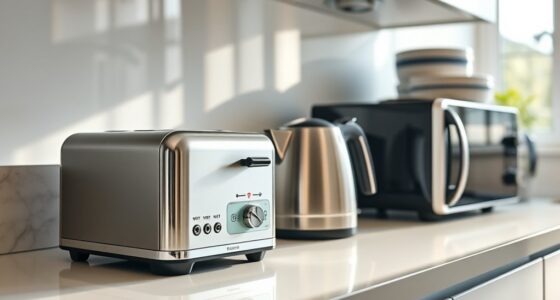Before you start, make a checklist by noting down each appliance’s wattage listed on labels or manuals. Add up the wattages to see if your circuits can handle the total load, and consider the amperage and voltage to guarantee safety. Check if your system needs upgrades for high-power devices like HVAC or water heaters. Choosing energy-efficient appliances can also reduce strain. Keep exploring to discover more tips on safe, efficient wattage planning.
Key Takeaways
- List all appliances and note their wattage from labels or manuals.
- Calculate the total wattage for devices expected to run simultaneously.
- Ensure your electrical system’s circuit capacity can handle the combined load safely.
- Verify voltage and amperage ratings to match appliance requirements and circuit limits.
- Consider energy-efficient appliances to reduce overall wattage and improve safety.
Electrical Load Planning and Energy Efficiency

Planning your appliance wattage is essential to make certain your electrical system can handle your household’s needs safely and efficiently. When you’re preparing to add new appliances or upgrade existing ones, understanding wattage helps you avoid overloading circuits, which can lead to electrical hazards or system failures. A key aspect of this process is considering energy efficiency. Choosing appliances with higher energy efficiency ratings not only reduces your power consumption but also minimizes the strain on your electrical system, making your home safer and more cost-effective in the long run.
Proper appliance wattage planning ensures safe, efficient electrical system performance and promotes long-term energy savings.
Before you purchase or install any new device, check its wattage rating—usually listed on the label or in the user manual. This number tells you how much power the appliance requires to operate. Add up the wattages of all appliances that might run simultaneously to ensure your circuits can support their combined load. If your total exceeds what your circuits are rated for, you risk circuit overloads, which can cause tripped breakers or, worse, electrical fires. Remember, safety considerations should always be at the forefront of your planning: never underestimate the importance of proper wiring, adequate circuit capacity, and the use of appropriate outlets and breakers.
In addition to total wattage, consider the amperage ratings of your circuit breakers. Since wattage is calculated by multiplying voltage (typically 120V or 240V in homes) by current (amperes), knowing both helps you determine whether your existing electrical system can handle your household’s needs. If you’re uncertain, consult a qualified electrician to evaluate your system. They can recommend upgrades or adjustments to safely accommodate your appliance load, especially if you plan to add high-wattage devices like HVAC units, electric water heaters, or large kitchen appliances.
Planning for energy efficiency also involves selecting appliances that operate effectively at lower wattages. Modern, energy-efficient models may have a higher upfront cost but save you money over time through lower electricity bills and reduced electrical strain. These choices contribute to a safer electrical environment by reducing the likelihood of overheating wires or tripped breakers.
Additionally, understanding AI and automation in the context of household appliances can help you choose smarter, more efficient devices that optimize energy use and enhance safety. Ultimately, a thoughtful wattage plan protects your home and family. It ensures your electrical system is capable of supporting your appliances safely while also promoting energy efficiency. Taking the time now to evaluate your current setup and future needs can prevent costly repairs and dangerous situations down the line. Proper planning isn’t just about convenience—it’s about safeguarding your home and making sure everything runs smoothly and safely.
Frequently Asked Questions
How Do I Calculate Total Wattage for Multiple Appliances?
To calculate total wattage for multiple appliances, you need to add up each appliance’s power consumption, which is usually listed in watts on their labels. Check the appliance energy ratings and sum these wattages to find the total. This helps you plan your electrical capacity and avoid overloads. Always include a safety margin for future additions or unexpected power surges.
What Safety Precautions Should I Follow During Wattage Planning?
You should prioritize electrical safety by avoiding overloads on your circuits. Always verify your breaker capacity matches your total appliance wattage, and don’t exceed it. Use proper wiring and outlets rated for your load. Keep your work area dry and clear of clutter. Consider consulting a professional if you’re unsure. These precautions help prevent electrical hazards and guarantee safe wattage planning for your appliances.
How Often Should I Update My Appliance Wattage Estimates?
You should update your appliance wattage estimates every couple of years, or when you notice changes in energy efficiency or performance. Think of it as keeping your finger on the pulse—regular updates help you avoid surprises and extend your appliance lifespan. As technology evolves, so do wattages, so staying current guarantees your energy planning remains accurate and efficient, saving you money and energy in the long run.
Can Wattage Planning Affect My Electricity Bill Significantly?
Yes, wattage planning can profoundly impact your electricity bill. By focusing on energy efficiency and choosing appliances with lower wattage, you reduce energy consumption and save money. Proper wattage planning helps you avoid overloading circuits and ensures you’re not using more power than necessary. With mindful planning, you can optimize your energy use, leading to noticeable cost savings over time.
What Are Common Mistakes to Avoid in Wattage Planning?
You should avoid common mistakes like underestimating the power overload or making incorrect calculations. These errors can lead to overloading your circuits or underpowering appliances, causing damage or inefficiencies. Always double-check wattage ratings and make certain your total wattage doesn’t surpass your circuit’s capacity. By carefully planning and avoiding these mistakes, you maintain a safe, efficient electrical setup that prevents costly repairs and keeps your home running smoothly.
Conclusion
Now that you’ve mapped out your appliances’ wattage, you’re like a captain steering a ship through calm waters and rough seas alike. With careful planning, you’ll avoid overloads and save energy, making your home safer and more efficient. Think of this checklist as your trusted compass, guiding you smoothly toward a well-balanced electrical system. Stay vigilant, plan wisely, and enjoy the peace of mind that comes from knowing your energy needs are fully under control.









